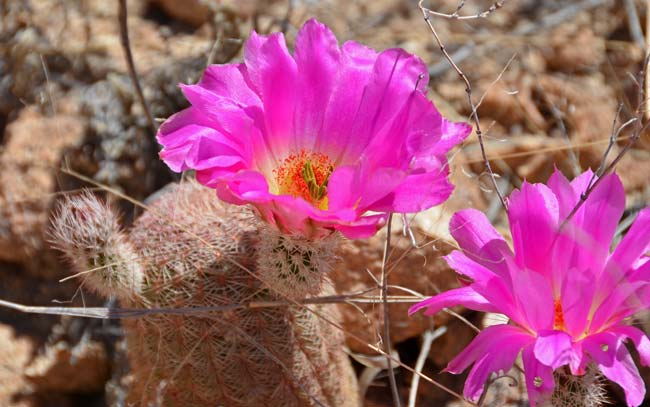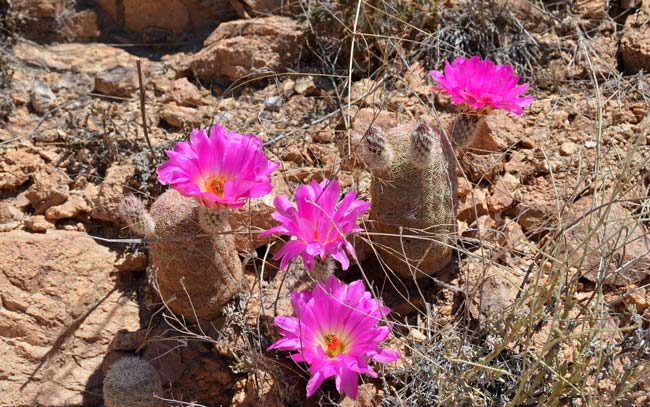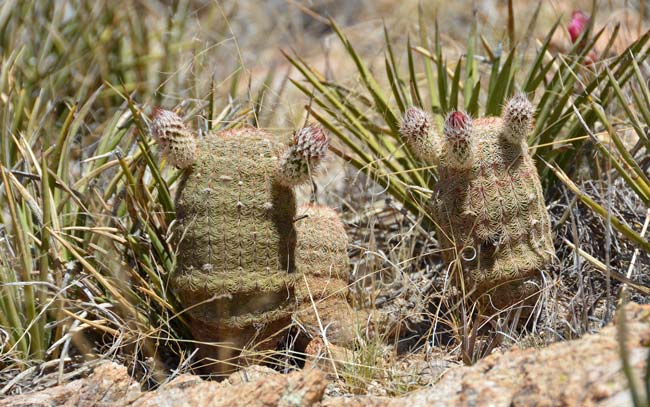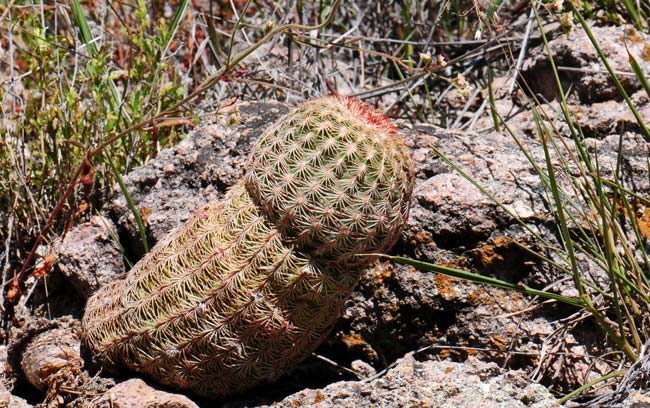Echinocereus rigidissimus, Rainbow Hedgehog Cactus




Scientific Name: Echinocereus rigidissimus
Common Name: Rainbow Hedgehog Cactus
Also Called: Arizona Rainbow Cactus, Rainbow Hedgehog Cactus (Spanish: Cabeza de Viejo)
Family: Cactaceae, Cactus Family
Synonyms: (Cereus pectinatus var. rigidissimus, Echinocereus pectinatus var. rigidissimus)
Status: Native
Duration: Perennial
Size: Up to 1½ feet tall.
Growth Form: Shrub; and unbranched Hedgehog with mostly solitary stems banded in red and white
Leaves: Leaves modified into spines emerging from areoles; lacking glochids; central spines absent and usually straight or slightly curved toward stem, spines bright pink to pink and white in alternating bands of color around the stem.
Flower Color: Rose-pink, lavender or magenta, flowers look over-sized on the squatty stems; conspicuously white banded below, over 1 inch long and 1.5 inches wide; anthers yellow; fruit juicy, greenish or dark purplish brown.
Flowering Season: May to August.
Elevation: 4,000 to 6,000 feet.
Habitat Preferences: Gravelly hills, rocky or sandy soils, steep canyon sides, grasslands, prefers limestone soils.
Recorded Range: In the United States Echinocereus rigidissimus is relatively rare where it is found in only in Arizona and New Mexico. It is also native to Mexico (Chihuahua, Sonora). In Arizona it is found in the central south and southeast parts of the state and in New Mexico it is found in the extreme southwest part of the state.
North America & US County Distribution Map for Echinocereus rigidissimus.
U.S. Weed Information: No information available.
Invasive/Noxious Weed Information: No information available.
Wetland Indicator: No information available.
Threatened/Endangered Information: Arizona: Echinocereus engelmannii is salvage restricted.
Genus Information: In North America there are 28 species for Echinocereus. Worldwide, The Plant List includes 64 accepted species names and a further 353 scientific names of infraspecific rank for the genus.
In the Southwestern United States: Arizona has 14 species of genus, California, Nevada and Utah each have 3 species, New Mexico has 12 species and Texas has 15 species. All data is approximate and subject to taxonomic changes.
Comments: Rainbow Hedgehog Cactus, absent a central spine, was originally thought to be a variety of Echinocereus pectinatus var. rigidissimus, also with the common name of Rainbow Hedgehog. However typical E. pectinatus has central spines, flowers indistinguishable from Rainbow Hedgehog and is chiefly a Mexican species collected in Arizona in the Perilla Mountains, Cochise County (Harlan 1939).
In Southwest Desert Flora also see: Pinkflower Hedgehog, Echinocereus bonkerae, Scarlet Hedgehog Cactus, Echinocereus coccineus, Hedgehog Cactus, Echinocereus engelmannii and Pinkflower Hedgehog Cactus, Echinocereus fasciculatus.
Rainbow Hedgehog Cactus has been used for food by southwestern United States indigenous peoples.
See complete listing of ethno-botanical uses at Native American Ethnobotany, University of Michigan, Dearborn.

